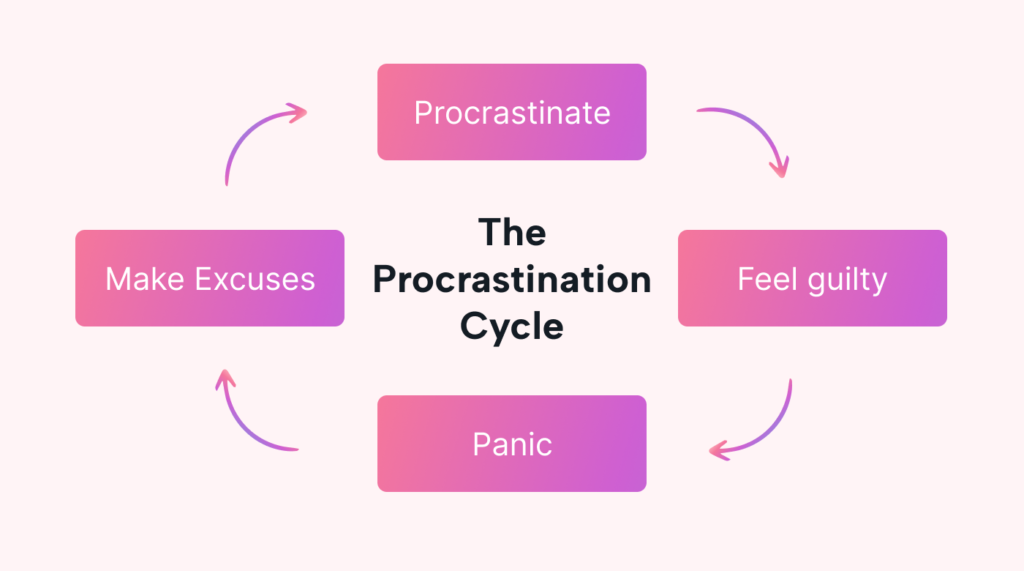
1.Introduction
Do you often postpone your work to the last moment and and ask yourself ”How To Overcome Procrastination And Laziness”? Well here me out, ”you are not alone” Studies show that around 20% of adults procrastinate chronically. No doubt, Procrastination is one of the biggest problem of 21st century. In this blog we will examine the underlying reasons of procrastination and will guide to towards the practical steps to overcome it. Whether you struggle with putting off work or simply want to boost your productivity, these tips can help you take proactive steps toward conquering procrastination and unlocking your full potential.
let’s dive in and understand how to overcome procrastination and laziness.
Definition of procrastination:
Procrastination is the act of unnecessarily postponing decisions or actions. For example, a person is procrastinating when they delay working on an assignment until right before its deadline for no reason, even though they know that it would be better for them to start earlier.
- The dictionary meaning of procrastination according to Cambridge dictionary is to keep delaying something that must be done, often because it is unpleasant or boring: Source : Cambridge
Causes of Procrastination
Understanding the root causes of procrastination is vital for answering How To Overcome Procrastination And Laziness effectively.
Fear of Failure:
This is the fear about not meeting one’s or others’ expectations, leading to task avoidance. For example “A student might delay tackling a difficult assignment due to their apprehension about receiving a poor grade.”
Lack of Motivation:
Procrastination often arises when there’s a lack of enthusiasm or a clear reason to initiate a task. For instance, someone might postpone starting a fitness regimen because they haven’t found a workout routine that excites them.
Perfectionism:
Procrastinators may delay tasks due to the desire for flawless outcomes, fearing that anything less would be unacceptable. For example, an artist might put off starting a painting because they’re fixated on creating a masterpiece.
High dopamine need:
Some individuals are drawn to the adrenaline rush of last-minute pressure, leading to procrastination. For instance, a student might wait until the night before an exam to study because the urgency motivates them.
No time management schedule:
Without a structured plan, it’s challenging to allocate time effectively, leading to procrastination. For example, someone might delay a work project because they haven’t set aside dedicated hours to complete it.
Distractions:
The presence of distractions like smartphones or a noisy environment can hinder concentration and promote procrastination. For example, an office worker might postpone a report because they keep getting interrupted by email notifications.
Multitasking:
Attempting to handle multiple tasks simultaneously can reduce efficiency and encourage procrastination. For instance, a student might delay their homework because they’re trying to simultaneously chat with friends, browse social media, and study.
Never starting:
Procrastination can also result from never even beginning a task due to inertia or a lack of a starting point. For example, someone might keep postponing cleaning their cluttered garage because they don’t know where to begin.
III. The Procrastination Cycle

The procrastination cycle is a pattern of behavior that individuals often go through when they procrastinate on tasks. It typically consists of several stages, and it can perpetuate the habit of procrastination. Here’s an explanation of the procrastination cycle:
Task Avoidance: The cycle begins with the avoidance of a task or the decision to delay it. This can happen for various reasons, such as a lack of motivation, fear of failure, or simply not wanting to engage with the task at hand.
Initial Relief: Initially, avoiding the task can provide a sense of relief or temporary comfort. This is because the individual escapes the immediate stress or discomfort associated with starting the task.
Increasing Stress: As time goes on, the stress and anxiety related to the unfinished task start to build. The individual may become increasingly aware of the impending deadline and the negative consequences of not completing the task.
Last-Minute Rush: As the deadline approaches, the stress reaches a peak, and the individual may experience a surge of adrenaline. This often leads to a last-minute rush to complete the task, resulting in lower-quality work and added stress.
Completion: In the end, the task is completed, but it may not meet the individual’s potential or expectations due to the rushed nature of the effort.
Temporary Relief: Completing the task provides a temporary sense of relief, as the immediate pressure is lifted.
Repetition: Unfortunately, the cycle often repeats itself with new tasks, perpetuating the habit of procrastination.
By Understanding the procrastination cycle one can easily grip the concept of how to overcome procrastination and laziness. By recognizing the pattern and implementing strategies to intervene at various stages, individuals can work toward more effective time management and improved productivity.
How To Overcome Procrastination And Laziness? 3-Essentials
1.Time Management Techniques:
Pomodoro Technique: The Pomodoro Technique is a time management method that breaks work into focused 25-minute intervals (Pomodoros) followed by short breaks. It helps maintain concentration and makes tasks feel less daunting.
To-do lists and prioritization: Creating to-do lists and prioritizing tasks enables you to organize your work effectively, ensuring that you address the most important tasks first, reducing the temptation to procrastinate.
Eat That Frog (Hardest Task First): This strategy involves tackling the most challenging or least enjoyable task first thing in the morning when your energy and willpower are at their peak. By “eating the frog,” you set a positive tone for the day and prevent task avoidance.
2.Motivation and Goal Setting:
SMART Goals:
SMART goals are Specific, Measurable, Achievable, Relevant, and Time-bound. They provide clarity and motivation by making it easier to track progress and remain focused on achievable targets.
Intrinsic vs. Extrinsic Motivation:
Distinguishing between intrinsic (internal) and extrinsic (external) motivations helps you align tasks with what genuinely drives you. Understanding your sources of motivation allows you to choose tasks that resonate with your values and interests.
5-Second Rule:
The 5-Second Rule, popularized by Mel Robbins, involves counting down from 5 and taking immediate action. This technique leverages a sense of urgency and bypasses hesitation, making it easier to start tasks and overcome procrastination.
3.Overcoming Psychological Barriers:
-
Overcoming Fear of Failure: Conquering the fear of failure involves reframing mistakes as valuable learning opportunities. By shifting your mindset, you can reduce the fear that often leads to procrastination, as you become less afraid of potential setbacks.
-
Managing Perfectionism: Managing perfectionism entails recognizing that perfection is rarely attainable and can hinder progress. Setting realistic standards and focusing on improvement over time can help mitigate perfectionistic tendencies, which often contribute to procrastination.
Practical Tips for Beating
Seeking Accountability and Support:
Don’t go it alone; enlist an accountability partner or support group to keep you on track. Sharing your goals and progress with someone who can offer encouragement and gentle nudges can be a powerful antidote to procrastination. When others are aware of your commitments, it becomes harder to procrastinate without consequences.
Developing a Routine and Sticking to It:
Crafting a daily routine that incorporates dedicated blocks of time for work, breaks, and even leisure can be a game-changer. Consistency reinforces discipline, making it easier to tackle tasks as they become ingrained habits. A well-structured routine minimizes decision fatigue and
creates a sense of predictability that counters procrastination tendencies.
Following these simple strategies on how to overcome procrastination and laziness will help you reclaim your time and boost your productivity.
-
Additional Resources
Books: ARTICLES
1. Atomic Habit 1. What Is Procrastination?
2 .5 sec rule 2.Procrastination: A Scientific Guide on How to Stop Procrastinating
3. Eat that frog 3.How to Stop Procrastinating
4. Feel good productivity
5. 7-Habits Of highly effective people
Conclusion :
In conclusion, understanding how to overcome procrastination and laziness is achievable through consistent effort and self-awareness. By addressing the root causes of how to overcome procrastination and laziness, you can develop sustainable strategies for improved productivity and motivation. Moreover, journaling is a powerful to manage time effectively, boost productivity and overcome procrastination . To 10x your productivity read the full article now!
How to start Journaling – The Ultimate Guide
FAQS
What are the best time management apps for 2023?
These are my favorite time management apps
-
ClickUp
-
Wrike
-
Monday.com
-
Todoist
-
RescueTime
-
Toggl Plan
-
Google Calendar




4 thoughts on “How To Overcome Procrastination And Laziness (3-Essentials)”